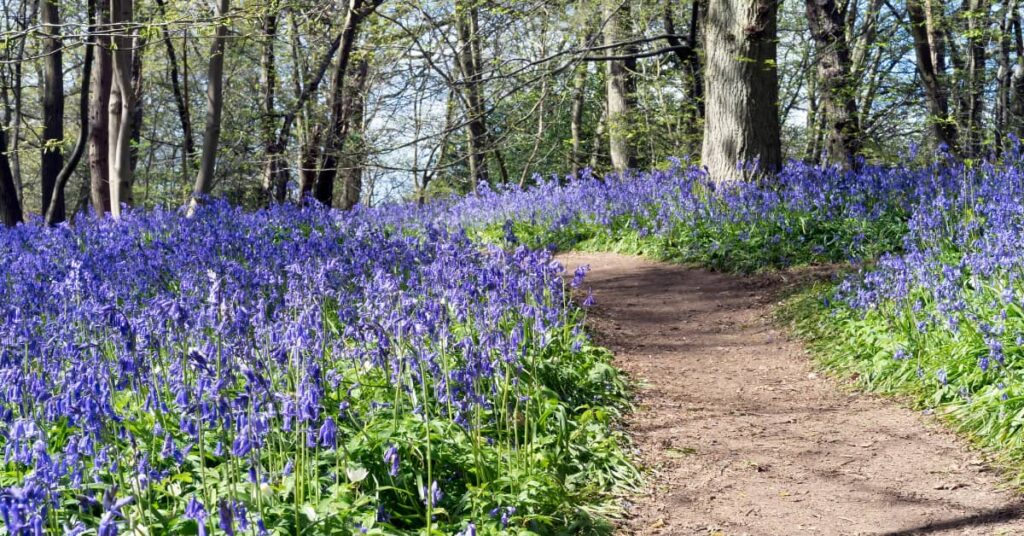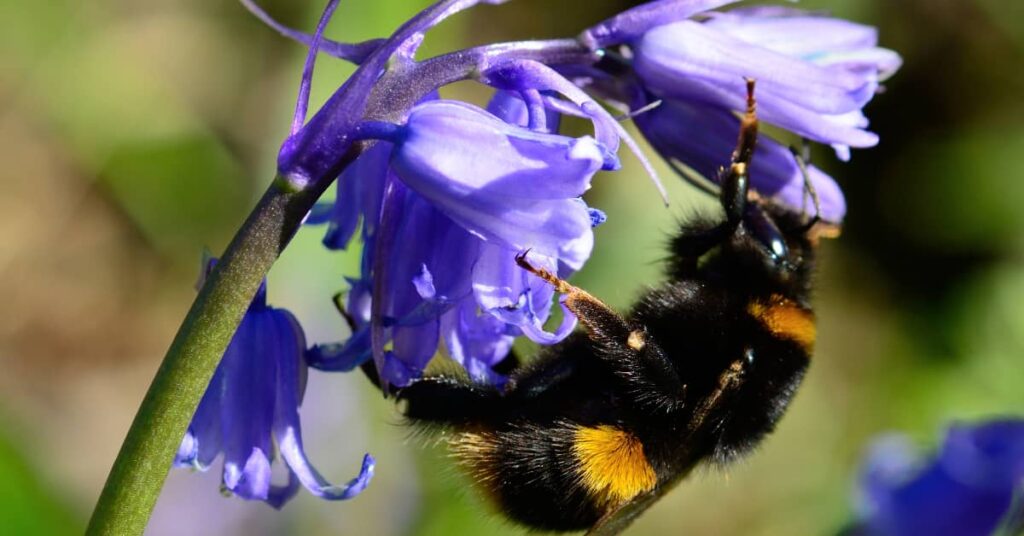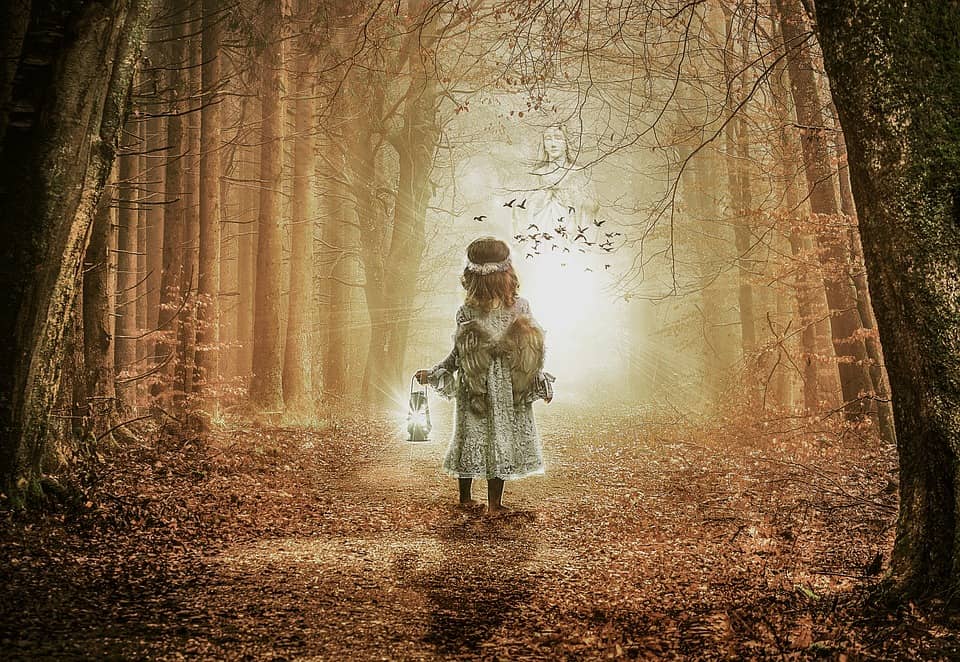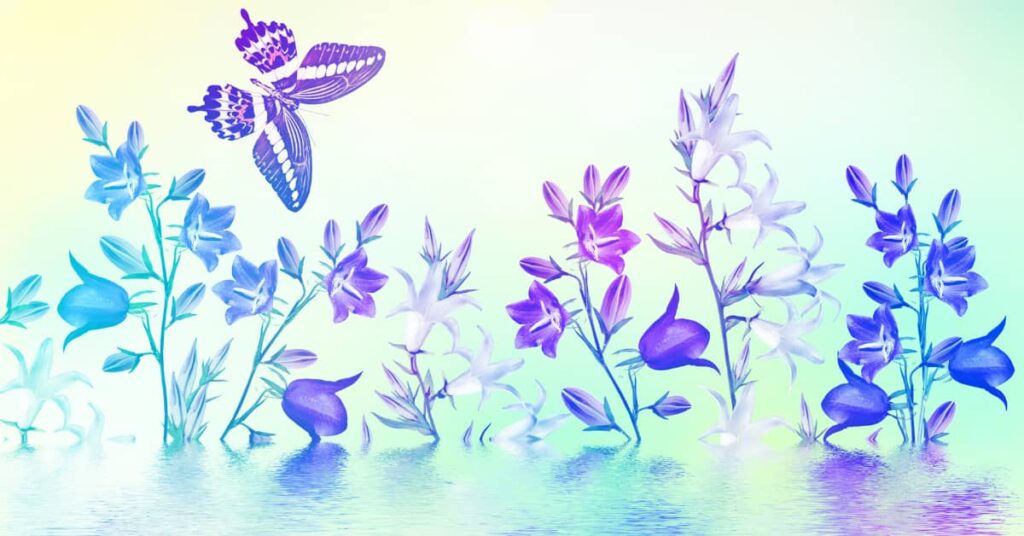Just Wow! Bluebell Woods Warrenpoint Northern Ireland

Where is Bluebell wood near me?
The Bluebell flower makes a glorious appearance in bloom in springtime in Ireland!
The Bluebells are also known as the wood hyacinth.
Warrenpoint is surely one of the best places in Northern Ireland to enjoy the beauty of the bluebells.
The Bluebells arrive almost overnight like a spring blue carpet on the forest floor. The sea of blue is enchanting and peaceful and does your heart good standing in their midst.
The heavenly blue is nature’s way of letting us know spring has arrived!
(…or perhaps it’s the magic of the fairies at work!)
Bluebells are one of the most beloved flowers in the world, with their unique blue-purple colour, delicate shape, and sweet fragrance capturing the hearts of many.
One of the most notable features of bluebells is their striking blue-purple colour. This hue is not commonly seen in many other flowers, making it a standout feature.
The bell-shaped petals of bluebells are unique and delicate, giving the flowers an elegant and charming appearance. The flowers hang downwards, adding to their graceful and attractive nature.
Warrenpoint Bluebells : Enchantment and Magic
We already know we live in a mystical area of magic and enchantment.
From Finn McCool to Narnia, our little corner of the world is a special place.
And no better proof that the fairies live among us, that we are blessed with such a beautiful Bluebell wood!
When you walk through the Blue bell wood there is a sense of wonder and magic all around!
The real magic is the fragrance and beauty of nature!
It truly is a wildflower spectacle!
Did you know there is an old fairy story if a child picked a Bluebell, they would never be seen again!!!

(Best not to pick them just in case – they play a vital role in our local ecosystem – read more below)
What does the Bluebell flower represent?
It is said the Bluebell flower is the symbol of gratitude, love and humility.
Floriography is the language of flowers and was used by the Victorians to send coded messages.
So if you got a bunch of Bluebells from someone, you now know what it would have meant!
What month do Bluebells flower?
Bluebells will flower depending on how mild our winter is. A cold winter can mean that the Bluebells will come into bloom late.
We usually have it mild in Ireland during the winter.
(Remember the Beast from the East in 2018 – the arrival of the Beast From the East to our shores.)
The bluebell is a bulbous herb that spends most of it’s life underground emerging around this time of year.
Each flower has six petals with it’s up turned tip revealing all it’s beauty.
Bluebell Season
As you will see if you take a visit to the Bluebell Wood in Warrenpoint, there must be millions of flowers all seeking out the warm rays of the sun.
As you will read below, they have the wood floor to themselves and have no woodland competition.

8 Amazing Bluebell Facts!
- Half of the world’s population of Bluebells grow in the UK and Ireland!
- It takes the Bluebell 5 YEARS!!! to grow from a seed to the glorious blue bulb we all get to enjoy!
- Bees just love the Bluebell as much as we do (so be careful not to trample on them both)
- The Bluebell is an early source of nectar for the Bees (don’t pick them! They are precious for our environment)
- The Blue Bell is a sign of an ancient woodland
- Our ancestors would have used the Bluebell to make glue!
- The Bluebell is at the centre of many ancient legends and myths
- Scientists are investigating the healing power of the Bluebell to cure diseases
Bluebells bloom?
Bluebells flower before all other plants in the woods. They have no pollinator competition and thus grow in their abundance.
The Blue bell leaf is 7mm to 25mm wide and 45cm in length. They are strap-shaped, smooth and hairless, with a pointed tip.
Check out a video below of our beautiful Blue Bell Wood!
Be Aware!
Blue Bell Wood is on private ground so be respectful if you visit!
Stick to the paths and do not trample on or pick the flowers (remember, they have an important job to do).
The location of the Bluebell Wood can be found at Narrow Water Forest.
Narrow Water Forest is a mixed broadleaf and coniferous forest located between Newry and Warrenpoint.
Access to the Blue Bell road is from via a really busy, fast dual carriageway.
So take care when parking along the carriageway lay by and when getting in and out of your car.
Saoirse and Flionn and the Disappearing Bluebells

Long ago in Ireland in a lush green bluebell wood at Narrow Water Forest, there was a group of fairies who lived among the flowers and trees.
Two of those fairies, Saoirse and Flionn, who were known for their love of music, dance, and all things beautiful.
Among the many flowers that grew in the forest, there was one that Saoirse and Flionn held especially dear – the bluebell.
The bluebell was a delicate flower with a sweet fragrance and a bright blue colour that reminded the fairies of the summer sky.
Saoirse and Flionn would often gather around the bluebells, using their petals to make dresses, hats, and other adornments for their parties and festivals.
One day, a mischievous Puca who lived on the outskirts of the forest noticed the fairies’ love for the bluebells.
He was jealous of the fairies’ beauty and magic, and he wanted to cause trouble. So, he decided to play a trick on the fairies by hiding all the bluebells in the forest.
Saoirse and Flionn were distraught when they woke up one morning and saw that all their beloved bluebells had vanished.
They searched high and low, but they could not find a single flower. The fairies began to lose hope, and they feared that they would never see the bluebells again.
They went to Danu who was the Irish Goddess of the forest and asked her for her help. Danu told them to sing a song about their love of the bluebell to the forest and that would break the spell.
So Saoirse and Flionn began to sing:
“Bluebells blooming in the glade, my Love for them will never fade, With petals blue as the summer sky, In their beauty, my heart does lie”
and then, something miraculous happened. As Saoirse and Flionn were wandering through the forest, they heard a faint sound in the distance.
The sound grew louder and louder until it became clear that it was the sound of music – the most beautiful music the fairies had ever heard.
The fairies followed the music to a clearing in the forest, where they found a group of bluebells swaying and dancing in the breeze. The fairies were amazed and overjoyed to see the bluebells alive and dancing, and they knew that it was magic at work.
Saoirse and Flionn realized that the magic of the bluebells was so strong that it had transformed them into living creatures.
From that day on, the bluebells continued to dance and sway in the forest, bringing joy and beauty to all who saw them.
Saoirse and Flionn learned to appreciate the magic and wonder of the natural world even more, knowing that anything was possible with a little bit of magic and a lot of love.
Can you hear the Bluebells sing when you visit the Bluebell Wood at Narrow Water Forest?
Can Bluebells be grown from seed in your own garden?

- Choose a location: Bluebell seeds prefer to grow in partial shade to full shade, so choose a spot in your garden that gets some sunlight but also has shade throughout the day. They also prefer well-drained soil that is slightly acidic.
- Plant the bulbs rather than seeds: Bluebells are typically grown from bulbs, which should be planted in the autumn. Plant the bulbs at a depth of about 3 inches, with a spacing of around 4 inches between each bulb.
- Water the bulbs: After planting the bulbs, water them well to help them establish themselves in the soil. Keep the soil moist throughout the growing season, but be careful not to overwater.
- Mulch around the bulbs: Mulching around the bulbs can help to keep the soil moist and cool, which is beneficial for bluebells. Use a mulch such as leaf mold, wood chips, or compost.
- Care for the plants: Bluebells don’t require much care once they’re established, but it’s a good idea to fertilize them with a balanced fertilizer in the spring. You can also deadhead the flowers once they’ve finished blooming to encourage more growth.
- Watch out for pests: Bluebells are generally fairly pest-resistant, but slugs and snails can be a problem. If you notice these pests, use a natural slug and snail control method such as beer traps or copper tape.
- Enjoy the blooms: Bluebells typically bloom in the spring, so be sure to enjoy their beautiful blue flowers while they last. After blooming, the foliage will die back, so you can cut it back or leave it to provide nutrients for next year’s growth.





